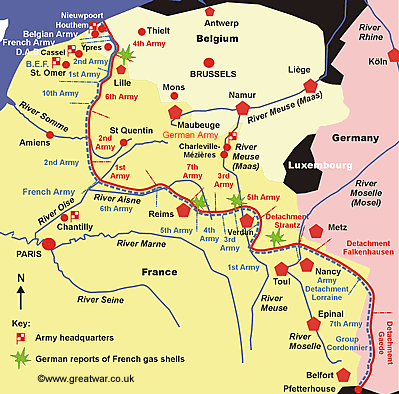 German justification for poisonous gas
German justification for poisonous gas
17 April 1915
Reports About the Allies' Use of Gas
With regard to the Declaration by the Hague Convention forbidding the use of poisonous or asphyxiating gas in warfare, the Germans continued to maintain that it was the French who first broke the rules of the Hague Convention. Indeed, the German Official Military History, 'Der Weltkrieg', states that already at the outbreak of war the French had a 26mm shell with a filling of Bromessigesterfullung, which they were planning to use in a siege or trench warfare situation. (1)
From the end of February 1915 'Der Weltkrieg' stated that German troops on the Western Front had reported the use of gas by the Allies. During the week prior to the German 22nd April gas attack the daily reports of the German General Staff mention the use of asphyxiating gas by French troops three times and British troops on one occasion:

13th April: The report stated that German troops were fired on by French artillery shells containing asphyxiating gas during fighting in the Champagne region at Suippes.
14th April: North-west of Verdun the French fired on the German front line with minenwerfer shells emitting thick, yellow smoke and suffocating gas.
16th April: Between the river Meuse (Maas) and river Moselle (Mosel) rivers the Germans reported an increase in the deployment by the French of asphyxiating gas. It was being carried in bombs dropped on German lines and bullets fired by the infantry.
17th April: The daily report stated that on the previous day the British had used bombs and shells containing an asphyxiating gas on the German line to the east of Ypres.
These official reports were apparently enough proof to convince German Supreme Command that the Allies had already been using gas against German troops on the Western Front for a few months.
French Handgrenades and Bullets Containing Gas
According to 'Der Völkerkrieg', published in 1915, the desire for retaliation formed the basis of the justification by the Germans to use gas against the Allies from April 1915. As further verification of the French deployment of gas, a communication from the French War Ministry, dated 21st February 1915, was published in the German translation by the 1915 historical publication 'Der Völkerkrieg'.
The communication contains details about the make-up of French handgenades and bullets which carried a liquid gas; after the shells or bullets exploded the gas seeped out and irritated the eyes, nose and throat of those who come into contact with it. It was stressed that the gas was not deadly, and the duration of its effectiveness in the air after it had been released from the shell was dependent on the strength of the wind. From the report 'Der Völkerkrieg' maintained that the French had obviously been developing and producing this gas for some months. It is not stated, however, at what date this French report became known to German High Command. (2)
The Justification for the German Use of Gas
Regarding the German development of gas weapons and the prohibited use of them by the Hague Convention the exact meaning of the words of the Declaration was loose enough for the Germans to argue their case for the permissible deployment of asphyxiating gas.
It was claimed that the German T-Shell gas weapon was not used for the sole purpose of spreading gas because it also had a detonating explosive charge. In the case of the gas cloud weapon it was argued that, although the gas cloud did have the sole purpose of spreading the gas amongst the enemy, it did not directly contravene the rules of the Declaration. This was because the gas used in the cloud was developed by German industry (i.e. the chemical dye industry) and not by the military. In addition, this gas did not go against the laws of human rights because the casualties caused by explosive artillery shells were far higher than those expected from the use of this gas. It was considered that casualties wounded by the effect of gas could mostly be healed.
Interestingly, the fact that gas was used by the German 4th Army in the Battle for Ypres in April 1915 is often omitted in German accounts of the battle written during the Great War or in the twenty years after it.
Acknowledgements
(1) Der Weltkrieg 1914-1918: Sommer und Herbst 1915, 8. Band
(2) Der Völkerkrieg, V. Band